Movement patterns, social dynamics, and the evolution of cooperation
- PMID: 22838026
- PMCID: PMC3566791
- DOI: 10.1016/j.tpb.2012.03.004
Movement patterns, social dynamics, and the evolution of cooperation
Abstract
The structure of social interactions influences many aspects of social life, including the spread of information and behavior, and the evolution of social phenotypes. After dispersal, organisms move around throughout their lives, and the patterns of their movement influence their social encounters over the course of their lifespan. Though both space and mobility are known to influence social evolution, there is little analysis of the influence of specific movement patterns on evolutionary dynamics. We explored the effects of random movement strategies on the evolution of cooperation using an agent-based prisoner's dilemma model with mobile agents. This is the first systematic analysis of a model in which cooperators and defectors can use different random movement strategies, which we chose to fall on a spectrum between highly exploratory and highly restricted in their search tendencies. Because limited dispersal and restrictions to local neighborhood size are known to influence the ability of cooperators to effectively assort, we also assessed the robustness of our findings with respect to dispersal and local capacity constraints. We show that differences in patterns of movement can dramatically influence the likelihood of cooperator success, and that the effects of different movement patterns are sensitive to environmental assumptions about offspring dispersal and local space constraints. Since local interactions implicitly generate dynamic social interaction networks, we also measured the average number of unique and total interactions over a lifetime and considered how these emergent network dynamics helped explain the results. This work extends what is known about mobility and the evolution of cooperation, and also has general implications for social models with randomly moving agents.
Figures


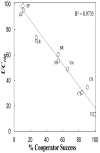
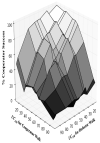

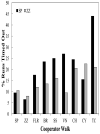

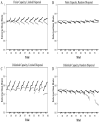
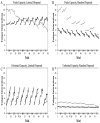
Similar articles
-
Mobility can promote the evolution of cooperation via emergent self-assortment dynamics.PLoS Comput Biol. 2017 Sep 8;13(9):e1005732. doi: 10.1371/journal.pcbi.1005732. eCollection 2017 Sep. PLoS Comput Biol. 2017. PMID: 28886010 Free PMC article.
-
Collective chasing behavior between cooperators and defectors in the spatial prisoner's dilemma.PLoS One. 2013 Jul 5;8(7):e67702. doi: 10.1371/journal.pone.0067702. Print 2013. PLoS One. 2013. PMID: 23861786 Free PMC article.
-
Invasion and expansion of cooperators in lattice populations: prisoner's dilemma vs. snowdrift games.J Theor Biol. 2010 Oct 7;266(3):358-66. doi: 10.1016/j.jtbi.2010.06.042. Epub 2010 Jul 7. J Theor Biol. 2010. PMID: 20619271 Free PMC article.
-
Examining the role of individual movement in promoting coexistence in a spatially explicit prisoner's dilemma.J Theor Biol. 2017 Apr 21;419:323-332. doi: 10.1016/j.jtbi.2017.02.028. Epub 2017 Feb 27. J Theor Biol. 2017. PMID: 28242201
-
Green-beard effect predicts the evolution of traitorousness in the two-tag Prisoner's dilemma.J Theor Biol. 2011 Nov 7;288:84-91. doi: 10.1016/j.jtbi.2011.07.023. Epub 2011 Aug 2. J Theor Biol. 2011. PMID: 21821051
Cited by
-
The Spatial Dynamics of Predators and the Benefits and Costs of Sharing Information.PLoS Comput Biol. 2016 Oct 20;12(10):e1005147. doi: 10.1371/journal.pcbi.1005147. eCollection 2016 Oct. PLoS Comput Biol. 2016. PMID: 27764098 Free PMC article.
-
Hunter-gatherer foraging networks promote information transmission.R Soc Open Sci. 2021 Dec 22;8(12):211324. doi: 10.1098/rsos.211324. eCollection 2021 Dec. R Soc Open Sci. 2021. PMID: 34950494 Free PMC article.
-
Empirically testing a relationship between cooperation and the prime numbers.R Soc Open Sci. 2024 Jun 19;11(6):231425. doi: 10.1098/rsos.231425. eCollection 2024 Jun. R Soc Open Sci. 2024. PMID: 39100144 Free PMC article.
-
Mobility can promote the evolution of cooperation via emergent self-assortment dynamics.PLoS Comput Biol. 2017 Sep 8;13(9):e1005732. doi: 10.1371/journal.pcbi.1005732. eCollection 2017 Sep. PLoS Comput Biol. 2017. PMID: 28886010 Free PMC article.
-
Aggregative cycles evolve as a solution to conflicts in social investment.PLoS Comput Biol. 2021 Jan 20;17(1):e1008617. doi: 10.1371/journal.pcbi.1008617. eCollection 2021 Jan. PLoS Comput Biol. 2021. PMID: 33471791 Free PMC article.
References
-
- Aktipis CA. Recognition memory and the evolution of cooperation: how simple strategies succeed in an agent-based world. Adapt. Behav. 2006;14:239–247.
-
- Atkipis CA. Know when to walk away: contingent movement and the evolution of cooperation. J. Theor. Biol. 2004;231:249–260. - PubMed
-
- Axelrod R. The Evolution of Cooperation. Basic Books; New York: 1984.
-
- Bartumeus F, da Luz MGE, Viswanathan GM, Catalan J. Animal search strategies: a quantitative random-walk analysis. Ecology. 2005;86:3078–3087.
-
- Beltran FS, Salas L, Quera V. Spatial behavior in groups: an agent-based approach. J. Artif. Societ. Soc. Simul. 2006;9:5. < http://jasss.soc.surrey.ac.uk/9/3/5.html>.
Publication types
MeSH terms
Grants and funding
LinkOut - more resources
Full Text Sources
